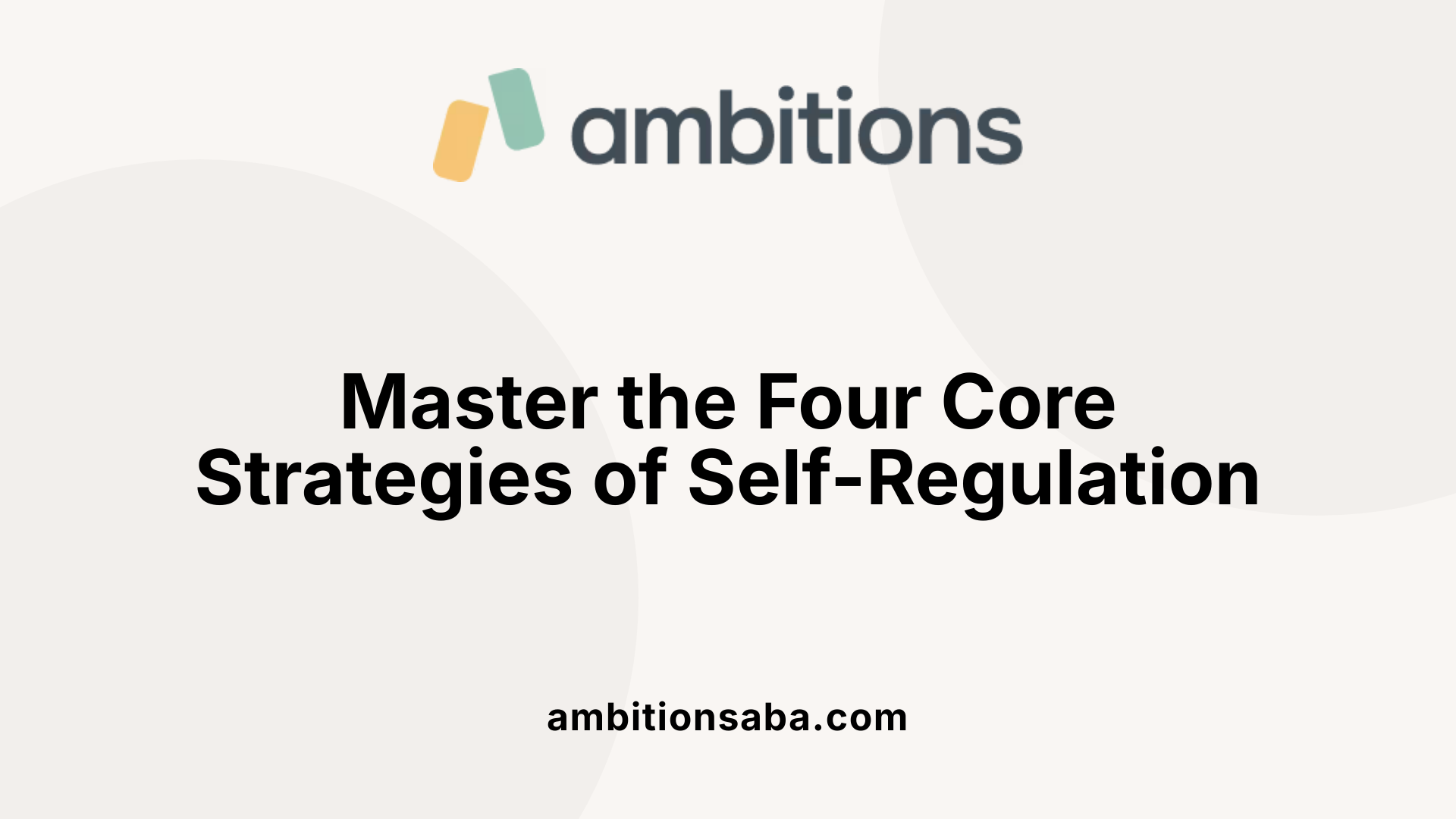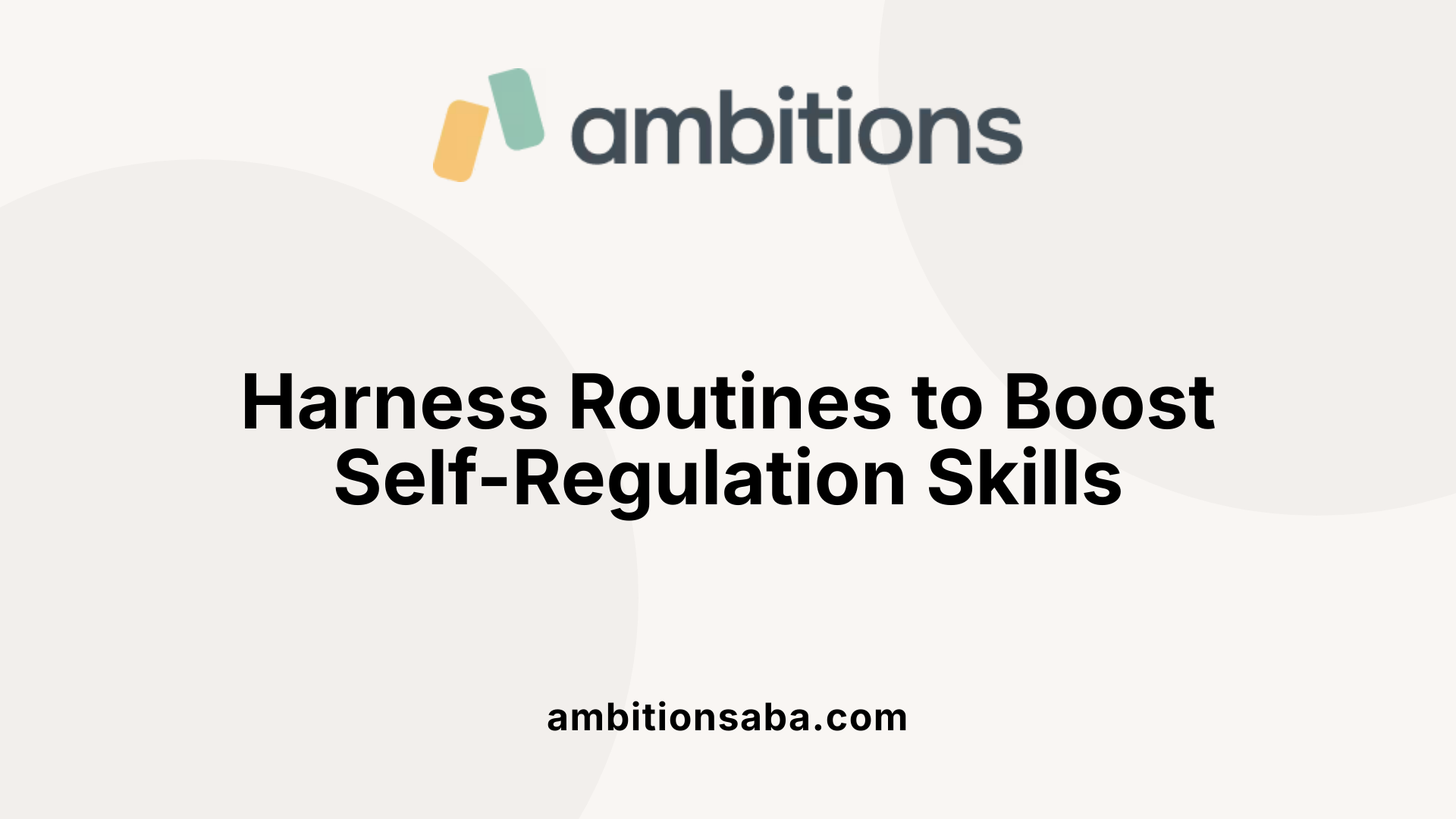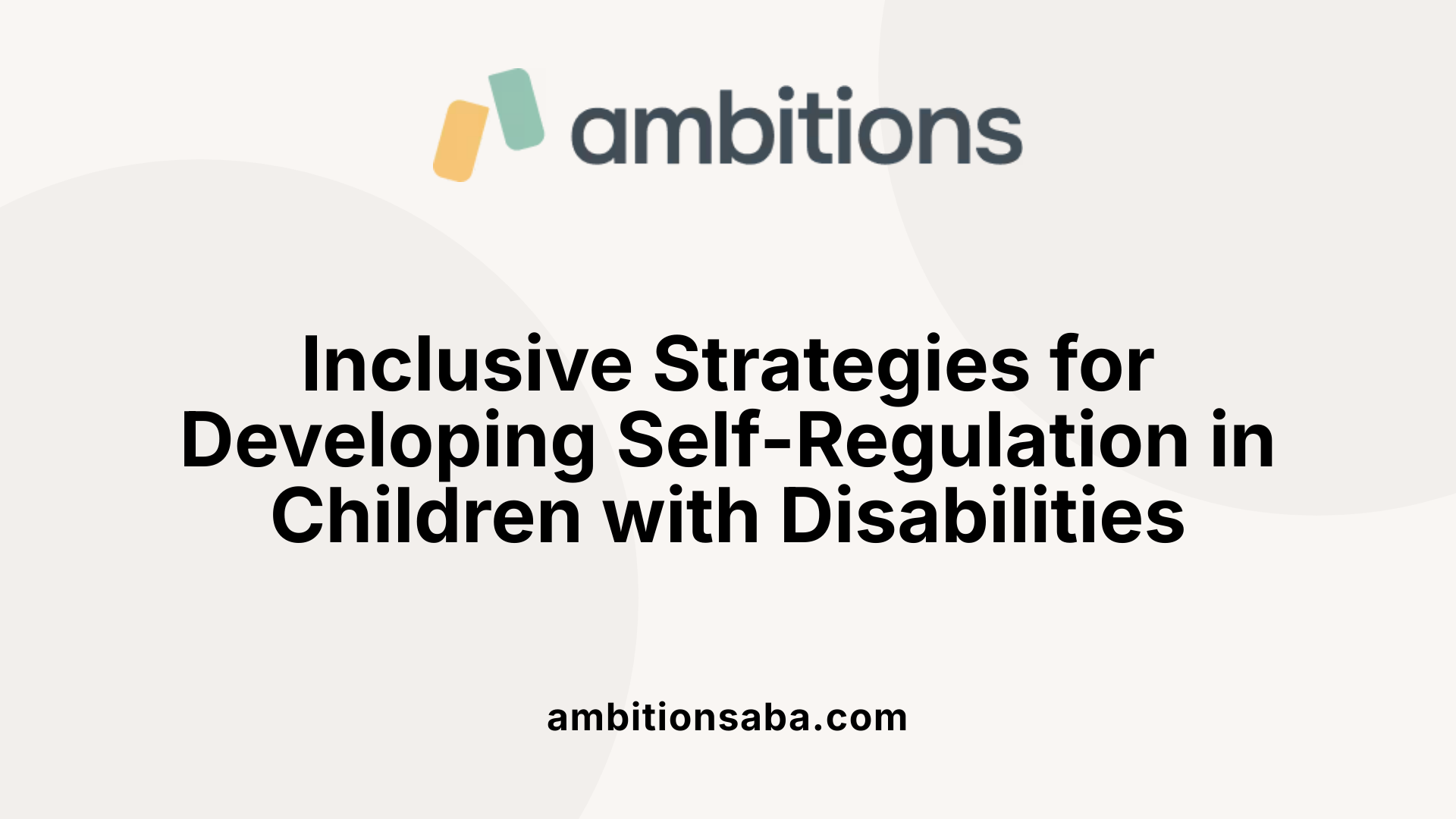Transforming Autism Support with Compassionate ABA
Introducing the Power of Routine in Developing Self-Regulation
Self-regulation is a vital skill that underpins children's success academically, socially, and emotionally. Teaching this skill through structured routines offers children predictable, safe environments where they can learn to manage their thoughts, feelings, and behaviors effectively. This article explores how routines serve as foundational tools in nurturing self-regulation and provides practical strategies for educators and caregivers.
Four Stages of Self-Regulation in Learning
Self-regulation in learning is a process that unfolds through four interconnected stages: forethought, monitoring, control, and reaction with reflection. These stages guide learners to plan, execute, and evaluate their learning strategies effectively.
The first stage, forethought, involves setting goals and planning how to approach learning tasks. Children and learners prepare by considering what they need to do and how they will accomplish it, fostering motivation and focus.
Next comes monitoring, where individuals keep track of their understanding, engagement, and progress. This self-awareness helps them recognize when they are on the right track or need to adjust their approach.
The control stage involves making adjustments—modifying behaviors, strategies, or thinking patterns to overcome obstacles or enhance performance. Developing control skills is essential for adapting to different tasks and challenges.
Finally, reaction and reflection encompass evaluating the outcomes of their efforts. This reflection helps learners assess their success, understand areas for improvement, and apply lessons learned to future tasks.
Research supports that addressing all four stages in educational settings enhances strategic thinking, problem-solving, and independence. Teachers can support this process by teaching goal-setting strategies, encouraging ongoing self-monitoring, guiding behavioral adjustments, and fostering reflective practices.
| Stage | Focus | Example Activities | Supporting Strategies |
|---|---|---|---|
| Forethought | Planning | Setting goals, predicting outcomes | Goal-setting exercises, visual goal charts |
| Monitoring | Self-awareness | Tracking concentration, understanding | Use of checklists, self-assessment tools |
| Control | Behavior adjustment | Changing strategies, managing impulses | Modeling control techniques, decision-making tasks |
| Reaction & Reflection | Evaluation | Reflecting on success, identifying challenges | Reflection journaling, group discussions |
Understanding these stages aids educators and students in developing comprehensive self-regulation skills, ultimately leading to more effective learning and personal growth.
The Four Cornerstone Strategies of Self-Regulation

What are the four basic self-regulation strategies?
Self-regulation is fundamental to helping children manage their emotions and behaviors effectively. Its development is supported by four core strategies: goal-setting, self-monitoring, self-instruction, and self-reinforcement.
Goal-setting involves guiding children to define clear, achievable objectives before they start an activity. For example, a child might set a goal to finish a puzzle in a certain amount of time or to raise their hand to answer a question. Developing concrete action plans helps children focus and stay motivated.
Self-monitoring requires children to observe and evaluate their actions continuously. This can be done through tools like checklists, logs, or self-assessment forms. For instance, a student might check off tasks as they complete them or reflect on how well they followed instructions. This awareness enables children to recognize areas needing improvement.
Self-instruction involves teaching children to use positive self-talk or internal dialogue to guide behavior. This might include phrases like "I can try again" or "Take a deep breath." It helps children manage frustration, plan their next steps, and stay focused on their goals.
Self-reinforcement refers to rewarding oneself after accomplishing a task or reaching a milestone. This could be as simple as giving a thumbs-up or offering a small treat. It boosts motivation and encourages children to keep practicing self-control and responsibility.
Together, these strategies create a robust framework for fostering independent, self-regulated learners capable of managing their emotions and behaviors in various settings.
How can these strategies be implemented in the classroom?
Teachers can integrate these strategies through explicit instruction and ongoing practice. For example, during morning routines, teachers can set goals with students and discuss their progress.
Visual tools like charts or digital apps help children track their behaviors, making monitoring engaging and accessible.
Modeling self-talk and highlighting its usefulness encourages children to adopt similar techniques.
Offering opportunities for self-reward—such as earning stickers or choosing a class activity—reinforces self-reinforcement.
These methods support emotional literacy, impulse control, and resilience, contributing to overall student success and well-being.
The Role of Routines in Enhancing Self-Regulation

How do routines support self-regulation?
Routines are fundamental in helping children develop self-regulation skills by offering a consistent, predictable structure. When children know what to expect, they feel more secure, which reduces anxiety and allows them to focus on learning and emotional growth.
A well-structured routine creates a safe environment where children can practice important self-regulation behaviors, such as waiting their turn, controlling impulses, and managing emotions. For example, daily activities like morning check-ins or transitions between tasks give children opportunities to engage in self-control and reflection.
Incorporating choices within routines also boosts children’s sense of autonomy. When children select activities or decide the sequence of tasks, they learn to make decisions and develop internal motivation, essential components of self-regulation.
Consistency in routines simplifies expectations and helps children internalize social norms, such as waiting patiently or sharing space. These skills are directly linked to successful social interactions and academic performance.
Furthermore, routines provide a foundation for emotional regulation. Predictable daily structures help children understand their environment better, leading to increased confidence in managing feelings and behaviors. Incorporating activities like calming corners or mindfulness moments within routines supports this development.
Additionally, routines that embed opportunities for practice—like using visual timers during transitions or engaging in sensory activities—strengthen children’s ability to manage their reactions. Each repeated practice enhances neural pathways involved in self-regulation.
Overall, routines are more than just daily schedules; they create nurturing frameworks that help children learn to govern their thoughts, feelings, and actions effectively. When routines are stable and flexible enough to include choices, they foster independence and resilience, empowering children to navigate their world with confidence.
Teaching Self-Regulation in the Classroom: Practical Strategies
How can self-regulation be taught in the classroom?
Teaching self-regulation involves implementing various activities and strategies that help children recognize, understand, and control their emotions and impulses. One effective approach is through sensory activities which target different senses to calm or energize students as needed.
Sensory activities may include tactile experiences like playing with stress balls, sensory bins, or textured materials. Movement-based exercises such as stretching, yoga, or quick physical games also promote regulation by releasing excess energy or calming the nervous system.
Visual tools are integral to teaching self-regulation. Visual schedules, emotion charts, and calming images help students identify their feelings and anticipate transitions. Visual stimuli like lava lamps or soft lighting create calming environments that support emotional regulation.
Auditory strategies include using calming sounds, gentle music, or white noise to help students settle down or focus. Teachers may also incorporate smell and taste options, like scented calm-down bottles or flavored treats, to engage additional senses.
Creating structured routines and explicitly teaching regulation strategies are fundamental. Practices such as deep breathing exercises, progressive muscle relaxation, or the Zones of Regulation framework provide children with practical tools for managing emotions.
A consistent, supportive classroom environment where feelings are acknowledged and validated helps students feel safe to express and regulate their emotions. Teachers modeling calm behavior, offering positive feedback, and providing frequent opportunities to practice these skills foster long-term self-regulation.
Overall, combining sensory activities, visual supports, auditory calming tools, and explicit instruction within a predictable environment helps children develop essential self-regulation skills, setting the foundation for successful social and emotional learning.
Incorporating Montessori Strategies for Self-Regulation
What techniques and approaches, including Montessori strategies, help foster self-regulation?
Montessori education emphasizes creating a respectful, predictable, and thoughtfully organized classroom environment. This approach helps children feel secure, allowing them to develop self-control and independence more effectively.
A cornerstone of Montessori strategies is offering children meaningful, purposeful activities that they can choose from. These activities promote engagement, personal responsibility, and problem-solving skills while encouraging children to learn through experience. When children have the opportunity to select tasks, they naturally practice decision-making and develop a sense of autonomy.
The role of choice is vital in fostering self-regulation. Giving children options within a structured setting allows them to understand natural consequences and promotes internal motivation. For example, choosing which activity to do or what materials to use helps children feel in control of their learning and emotions.
Modeling respectful and calm behavior is a key part of Montessori teaching. Teachers demonstrate self-regulation through their tone of voice, patience, and respectful communication, which children then imitate. This modeling helps children understand appropriate ways to manage emotions and handle conflicts.
Respecting children’s individual paces and choices also reinforces their self-esteem and emotional resilience. In Montessori environments, children learn to respect their own learning process and that of their peers, which supports emotional regulation.
Furthermore, Montessori classrooms incorporate conflict resolution and social-emotional learning through structured routines, role-playing, and opportunities for children to discuss feelings and solutions. These interactions deepen their understanding of social norms and emotional regulation.
In summary, strategies that foster self-regulation within the Montessori framework include providing purposeful and independent activities, encouraging decision-making, modeling respectful behavior, and supporting social-emotional growth. These approaches help children develop self-awareness, control, and resilience, essential for their overall development and success.
The Educator and Caregiver’s Role in Fostering Self-Regulation
What is the role of educators and caregivers in promoting self-regulation in children?
Educators and caregivers are fundamental in guiding children’s development of self-regulation. Their warm, responsive interactions help children feel safe and understood, which sets a foundation for emotional growth. By modeling calm and controlled behavior, adults demonstrate what self-regulation looks like in real life.
Establishing routines and predictability within the learning environment creates a structured setting, enabling children to anticipate transitions and manage their reactions better. Consistent daily schedules and visual cues help children learn self-control as they understand what to expect and when.
Teaching emotional literacy is another vital aspect. Caregivers actively coach children to recognize and articulate their feelings, practice problem-solving, and adopt coping strategies. These skills are reinforced through games, literature, and reflective exercises.
Creating a co-regulation environment, especially during early childhood, involves adults supporting children in managing their emotions. Techniques such as deep breathing exercises, designated calm spaces, and mindful activities help children learn to regulate impulses.
The quality of caregiving is also influenced by the caregiver’s own self-regulation skills. When adults effectively manage their stress and respond thoughtfully, they model resilience and patience, which children imitate.
Intervention programs and ongoing training for caregivers further strengthen these practices. By continuously developing their skills, educators and parents can better support children’s social, emotional, and academic success, fostering lifelong self-regulation skills.
Using Resources and Routines for Self-Regulation Development
How can resources and routines be used to support self-regulation development?
Implementing consistent resources and routines in the classroom is essential for helping children develop self-regulation skills. Visual aids, such as visual schedules, feeling charts, and social stories, serve as tools that children can easily refer to, helping them identify and understand their emotions. For example, feeling charts allow children to label their feelings, fostering emotional literacy and self-awareness.
Calming spaces and sensory tools also play a crucial role. Designated areas like calm corners or quiet zones offer children a safe haven to self-soothe and regain control when overwhelmed. Sensory activities, such as textured objects or calming lights, help regulate emotions and reduce stress.
Structured daily routines create predictability, which is vital for promoting self-control. Activities like morning check-ins, mindful movement, and structured transitions between tasks help children anticipate what’s next, reducing anxiety and impulsivity. Repeating routines like reinforce rules and reinforce expected behaviors, making it easier for children to manage their impulses.
Modeling self-regulation behaviors is an impactful strategy. Teachers and caregivers demonstrating calmness, deep breathing, and patience exemplify effective strategies children can imitate. Reinforcing these behaviors through positive feedback encourages children to adopt similar approaches.
Bringing together visual tools, calming environments, predictable routines, and positive modeling creates a comprehensive framework. This approach provides children with opportunities to practice self-regulation regularly, supports emotional growth, and builds resilience.
In the long run, such practices contribute to children’s ability to handle stress, control impulses, and develop social skills vital for success in school and life. Combining these resources and routines ensures that children have a supportive environment to learn and grow in emotional regulation.
Supporting Children with Disabilities in Developing Self-Regulation

How can children with disabilities develop self-regulation skills?
Children with disabilities can learn self-regulation through tailored strategies that address their unique needs. Using individualized visual supports, such as social stories, emotion charts, and visual schedules, helps children anticipate and understand daily routines and emotional cues. These visuals serve as consistent cues, reducing anxiety and promoting independence.
Creating a calm, structured environment is essential. Designated calming spaces, sensory activities, and appropriate routines provide safe areas for children to self-soothe when overwhelmed. Engaging in sensory activities, such as using textured materials, calming lights, or movement-based exercises, supports sensory regulation. Physical movements like stretching or deep breathing exercises, integrated into daily routines, also aid in calming and refocusing.
Teaching emotional literacy is vital. Helping children recognize, label, and express their feelings—using tools like emotion charts or social stories—enhances their understanding of emotions and builds coping skills. Techniques such as mindfulness, guided relaxation, and physical activities teach children to manage stress and emotional responses effectively.
Collaboration with specialists, including speech therapists, occupational therapists, and behavioral specialists, ensures that interventions are customized. Regular assessment and progress monitoring allow educators and caregivers to adapt approaches, ensuring each child's growth in self-regulation.
Adult modeling, positive reinforcement, and consistent practice further reinforce these skills. Teachers and parents can demonstrate calming behaviors, use appropriate language about emotions, and provide immediate feedback. Over time, these strategies help children develop greater emotional resilience, better social interactions, and improved academic performance.
Empowering Children: The Lasting Impact of Routine-Based Self-Regulation Education
Teaching self-regulation through structured routines equips children with essential life skills that foster emotional resilience, social competence, and academic success. By creating predictable environments, modeling appropriate behaviors, integrating Montessori principles, and providing tailored support, educators and caregivers lay the foundation for lifelong self-regulation. Ongoing research supports the importance of these practices in early childhood and beyond, emphasizing a holistic, compassionate approach to nurturing well-rounded, adaptable individuals.
References
- 19 Ways to Help Elementary Students Self-Regulate | Edutopia
- 10 Self-Regulation Skills and How to Effectively Teach Them
- Teaching Self Regulation Skills in Early Childhood - Brightwheel
- 15+ Classroom Practices to Build Self-Regulation Skills
- [PDF] Promoting Self-Regulation in the First Five Years: A Practice Brief
- Teaching Self-Regulation Skills Through Everyday Routines ~ Ep. 80
- Self-Regulation Strategies For Children With Disabilities
- Self-regulation strategies | EEF
- What is Self-Regulation? (+9 Skills and Strategies)
- How Do Montessori Self-Regulation Techniques Help Toddlers Thrive

